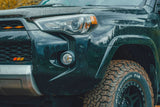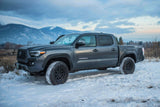Rock crawling is one of the most technical and rewarding forms of offroading. It's not about speed, it's about precision, control, and skill in navigating over jagged boulders, steep ledges, and uneven surfaces. For enthusiasts looking to push their vehicles to the limits of their capabilities, rock crawling provides the perfect challenge. Whether you're a seasoned off-roader or new to rock crawling, this guide will provide you with insights, tips, and gear recommendations to help you master the art of rock crawling.
What is Rock Crawling?
Rock crawling is an off-road discipline where drivers navigate their vehicles over rocky terrain, often moving at slow speeds to ensure maximum control. This type of offroading requires vehicles with higher ground clearance, excellent traction, and components that can withstand heavy stress. Unlike other forms of offroading that rely on speed and momentum, rock crawling is all about deliberate movements and patience, making it a highly technical and mentally engaging activity.
Essential Vehicle Modifications for Rock Crawling
1. Lift Kits for Ground Clearance
Ground clearance is crucial in rock crawling to avoid damage to your vehicle's undercarriage and to prevent getting stuck on large rocks. A modest lift from our lift kits can provide the extra clearance needed to safely navigate over obstacles while maintaining optimal handling. This ensures your vehicle can tackle uneven terrains without scraping the underside, offering a balanced approach to performance and protection.
2. Tires and Traction
Traction is everything in rock crawling. You need tires that can grip onto slippery, uneven rock surfaces and offer stability. All-terrain or mud-terrain tires are great options, as they provide deep treads that can bite into the terrain. Be sure to check for tires that are specifically designed for off-roading, with reinforced sidewalls to withstand the jagged edges you'll encounter.
3. Skid Plates
Skid plates are protective armor installed under your vehicle to protect vital components like the oil pan, transfer case, and fuel tank. While our lift kits provide extra clearance, skid plates are a must-have for any serious rock crawler to prevent expensive damage when rocks inevitably scrape against the underside of your vehicle.
4. Locking Differentials
While not an extreme modification, locking differentials are an essential upgrade for rock crawling. In challenging situations where one wheel is suspended in the air or loses traction, a locking differential forces both wheels on the same axle to spin at the same speed, allowing your vehicle to keep moving forward even when traction is compromised.
5. Recovery Gear
Even with the best preparation, rock crawling can be unpredictable. Always carry recovery gear such as a winch, tow straps, and D-rings. A winch can be used to pull your vehicle out of tricky spots, and tow straps can be invaluable for assisting fellow offroaders or getting help from others when you're stuck.
Rock Crawling Techniques
In addition to modifying your vehicle, mastering the right driving techniques is key to successful rock crawling.
1. Tire Placement
The key to rock crawling is tire placement. Always plan your route so that your tires hit the high points of rocks. This ensures that your vehicle maintains traction and prevents the underside from getting hung up. Slow down and take time to read the terrain ahead. Moving slowly allows you to make adjustments and prevent abrupt impacts that could damage your vehicle.
2. Throttle Control
Smooth and steady throttle control is essential. In rock crawling, spinning your tires wildly can result in losing traction and potentially damaging your vehicle. Instead, apply power gradually to allow your tires to grip onto rocks. A common mistake is over-revving the engine, which can send you bouncing uncontrollably over the terrain.
3. Momentum
While most of rock crawling is slow and steady, some obstacles require just a bit of momentum. If you're approaching a steep incline or a large rock that you need to climb over, a brief increase in throttle can help you clear the obstacle. However, balance is key—too much speed, and you risk damaging your vehicle.
4. Articulation
Rock crawling relies on a vehicle's ability to articulate, or flex, its suspension over uneven terrain. While extreme modifications aren't necessary, choosing the right lift kit—such as our 2" or 3" block lifts—will help increase wheel travel and articulation. This ensures that each wheel remains in contact with the ground as much as possible, maintaining traction and control.
5. Line Choice
Picking the right line, or path, through a rock field can mean the difference between success and getting stuck. Choose a line that keeps your vehicle level and minimizes the risk of high-centering (when your vehicle's underside gets stuck on a rock). Always try to approach steep obstacles head-on, rather than at an angle, to avoid tipping your vehicle.
Choosing the Right Terrain
When starting out in rock crawling, it's important to choose terrain that matches your skill level. Start with smaller rock gardens or moderate trails where you can practice your skills. As you build confidence, you can progress to more challenging terrain.
Popular Rock Crawling Destinations:
-
Moab, Utah: Famous for its unique red rock terrain, Moab offers trails for all skill levels.
-
Rubicon Trail, California: This legendary trail is one of the most challenging rock crawling routes in the U.S.
-
Rausch Creek Off-Road Park, Pennsylvania: A great location for beginners and intermediate rock crawlers, offering varied terrain and designated rock crawling areas.
Essential Rock Crawling Safety Tips
-
Travel in Groups: Never go rock crawling alone. It's important to have others around in case of an emergency or recovery situation.
-
Know Your Limits: Both your vehicle and your skills have limits. Don’t attempt obstacles that could lead to dangerous situations.
-
Bring a Spotter: A spotter can help you navigate tricky sections by providing real-time guidance from outside the vehicle.
-
Inspect Your Vehicle: After every rock crawling trip, inspect your vehicle for damage, paying special attention to the tires, suspension, and undercarriage.
Final Thoughts
Rock crawling is an exhilarating way to experience off-roading, requiring both technical skill and a well-prepared vehicle. By making smart upgrades like installing our lift kits, using the right tires, and following key driving techniques, you can safely navigate rugged terrain and enjoy everything rock crawling has to offer.
If you're ready to get your vehicle rock-crawling-ready, check out our range of lift kits and accessories. Whether you're driving a Silverado, Titan, or another offroad-ready vehicle, Reaper Offroad Lifts has the equipment to elevate your adventure. Don’t let your off-road adventures get buried by low clearance—raise your ride with our lift kits and let it dominate the trails like a true reaper of rugged terrain.





0 comments